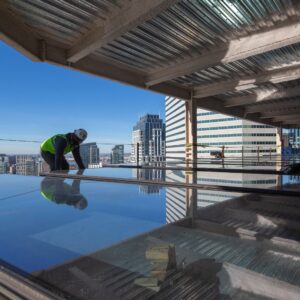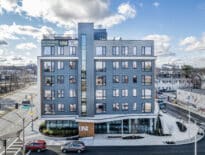
A construction worker stages glazing for developer Hines’ 35-floor South Station Tower during the winter of 2023-2024. The building could be the last big office building to rise in Boston for the next 20 years, if predictions by some leading real estate experts come true. Photo courtesy of Hines
When Hines’ South Station Tower opens next year, it will be one of the largest office projects ever built in the city, with 35 floors of offices topped by 16 stories of condominiums.
It may very well be one of the last as well.
The implosion of the office market in the wake of the pandemic and the rise of remote work is reaching a boiling point after three years of simmering, with companies concluding they need a lot less space now.
The official vacancy rate, as high as it is right now, doesn’t really tell the full story. Roughly 20 percent of office space in the Boston area is currently available for rent, a number typically seen during economic downturns.
But that doesn’t measure all the space that, on paper, is currently leased out to one company or another, but is sitting empty, with the workers who once occupied and offices now toiling away on their laptops at home or in local coffee shapes.
The occupancy rate, a metric emerged in the wake of the pandemic, measures that very relevant statistic – for companies, unless they have lost leave of their senses, will not continue to pay high, downtown rents for offices no one is using.
And despite efforts by major companies, by enticements or threat, to get workers back in the office, as much as half of the nation’s corporate suites are currently unoccupied, even if a significant proportion are officially still leased under long-term deals, according to the Kastle Group, which tracks how many employees badge into office towers in many of the nation’s biggest office markets, Boston excepted.
All those half-empty towers and buildings, in turn, are just not worth as much as they were before. That has triggered defaults on loans by owners and a plunge in assessed values that is already raising the specter of a looming tax revenue crunch in Boston and other cities.
Where’s the Bottom?
It’s not even clear, in fact, that we’ve reached the bottom yet. After all, there is still a ton of office space out there that while empty, is officially leased out under long-term deals that may very well not expire until the decade, if not later.
The consensus of some of the nation’s top office market experts in a recent piece in CoStar News is that the office market likely hasn’t hit bottom yet, though it may be close to reaching its nadir.
If nothing else, the habits of 2019, when most people commuted daily to work at some office or another, are gone and are not coming back.
And the road to recovery is likely to be long and arduous.
Richard Barkham, global chief economist at CBRE, told CoStar News’ journalists that he sees a rough parallel with the crisis that has confronted malls amid the shift to online shopping.
It has taken regional malls roughly eight years to regain a stable footing, Barkham said.
Along the way, malls have been forced to reinvent themselves, with former anchor department stores turned into entertainment hubs and lots and buildings being converted into apartments and condos as well.
A Generation Before Building Returns
And Barkham sees potentially an even longer period of recovery ahead for the office market.
In fact, it could take a decade, or even 15 to 20 years, before the office market finds its new state of equilibrium, he said.
Along the way, the overall office market will likely shrink. Some buildings, no longer able to compete in a market where demand for office space has fallen dramatically, will likely wind up meeting the wrecking ball.

Scott Van Voorhis
“I think that’s probably likely what’s going to happen to office, but it’s going to fully recover around a smaller footprint,” Barkham told CoStar News.
It’s not too hard to imagine that happening in Boston. There has been a lot of talk about converting older, class B office buildings into apartments and condos, but not all buildings have layouts conducive to such a shift.
Here’s one thing that would be hard to imagine, though: A developer deciding that what Boston really needs is another office tower and investors and banks rushing to put up the billion dollars or more needed to build it.
That’s not happening the rest of this decade, and it’s doubtful we are going to see it in the 2030s, either. Maybe the 2040s, but that’s a long, long way off.
The recent opening of the Winthrop Center and One Congress Street towers, along with the South Station tower next year, should keep the Boston well-stocked with top-shelf office space for years if not decades to come.
So, when will see another office tower built in Boston? Your guess is as good as mine.
Scott Van Voorhis is Banker & Tradesman’s columnist and publisher of the Contrarian Boston newsletter; opinions expressed are his own. He may be reached at sbvanvoorhis@hotmail.com.





